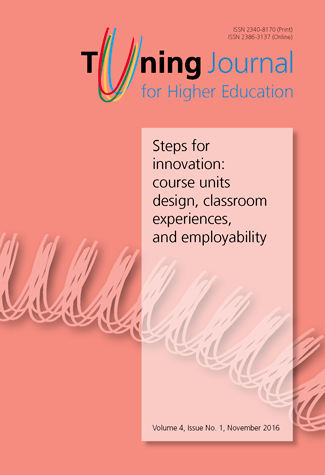Work-related teaching and learning methods to foster generic skills in Higher Education. An Italian experience
Abstract
Within the framework of modernisation of higher education systems in Europe, universities are invited to go beyond a knowledge-based perspective focused on disciplinary approaches and to be more concentrated on encouraging generic skills to deal with today’s complex and unpredictable career paths. The literature about Work-Related Learning and Work-Integrated Learning offers evidence to research regarding contributions of work-related experiences to the development of generic skills. The first part of the article presents a literature review carried out following the matching among three main keywords: work-related learning, generic skills, and higher education. Resources focused on the integration/teaching of generic skills in formal curriculum or in co-curriculum work-related activities and they were collected in order to explore the link between work-related learning in higher education and the development of generic skills. The focus is to identify valuable considerations to improve teaching strategies and methods. The second part presents an Italian work-related experience developed within the course of “Organizational Intervention Research Methods,” which involved 22 master’s degree students. The work-related assignment will be described in addition to the content analysis process of the 22 collected texts and the findings about the development of generic skills.
Published online: 30 November 2016
Downloads
References
Abeysekera, Indra. “Issues relating to designing a Work-Integrated Learning (WIL) program in an undergraduate accounting degree program and its implications for the curriculum.” Asia-Pacific Journal of Cooperative Education 7, no. 1 (2006): 7-15.
Atchison, Mary, Sarah Pollock, Ern Reeders, and Janine Rizzetti. Work integrated learning paper. Melbourne: RMIT University (2002).
Bennett, Neville, Elisabeth Dunne, and Clive Carré. “Patterns of core and generic skill provision in higher education.” Higher education 37, no. 1 (1999): 71-93.
Bridgstock, Ruth. “The graduate attributes we’ve overlooked: Enhancing graduate employability through career management skills.” Higher Education Research & Development 28, no. 1 (2009): 31-44.
Burchell, Noel, Dave Hodges, and L. Rainsbury. “What competencies do business graduates require? Perspectives of New Zealand stakeholders.” Journal of Cooperative Education 35, no. 2-3 (2000): 11-20.
Cannan, James. “Practice based learning: exploring current models used for real world learning at a “dual sector tertiary institution”.” WACE Asia Pacific Conference E-Proceedings (2008): 91-97.
Commission of the European Communities. A new partnership for the modernisation of universities: the EU Forum for University Business Dialogue, 2009. Accessed July 22, 2016. http://ec.europa.eu/transparency/regdoc/recherche.cfm?C=it.
Coll, Richard K., Chris Eames, Levinia Paku, Mark Lay, Diana Ayling, Dave Hodges, Shiu Ram, Ravi Bhat, Jenny Fleming, Lesley Ferkins, Cindy Wiersma, and Andrew Martin. “Putting the ‘integrated’ in work-integrated learning.” In World Association of Co-operative Education Asia Pacific 2008 Conference: Work Integrated Learning (WIL): Transforming Futures, Practice… Pedagogy… Partnerships (2008): 101-107.
Coll, Richard K., and Karsten E. Zegwaard. “Perceptions of desirable graduate competencies for science and technology new graduates.” Research in Science & Technological Education 24, no. 1 (2006): 29-58.
Cooper, Lesley, Janice Orrell, and Margaret Bowden. Work integrated learning: A guide to effective practice. Routledge, 2010.
Crebert, Gay, Merrelyn Bates, Barry Bell, Carol-Joy Patrick, and Vanda Cragnolini. “Developing generic skills at university, during work placement and in employment: graduates’ perceptions.” Higher Education Research & Development 23, no. 2 (2004): 147-165. doi: https://doi.org/10.1080/0729436042000206636.
Devadason, Evelyn Shyamala, Thirunaukarasu Subramaniam, and Esther Gnanamalar Sarojini Daniel. “Final year undergraduates’ perceptions of the integration of soft skills in the formal curriculum: a survey of Malaysian public universities.” Asia Pacific Education Review 11, no. 3 (2010): 321-348.
De Villiers, Rouxelle. “The incorporation of soft skills into accounting curricula: preparing accounting graduates for their unpredictable futures.” Meditari Accountancy Research 18, no. 2 (2010): 1-22.
Dirkx, John M. “Work-Related Learning in the United States: Past Practices, Paradigm Shifts, and Policies of Partnerships.” The Sage Handbook of Workplace Learning (2011): 293-306.
Drummond, Ian, Iain Nixon, and John Wiltshire. “Personal transferable skills in higher education: The problems of implementing good practice.” Quality assurance in education 6, no. 1 (1998): 19-27.
Eames, Chris, and Beverley Bell. “Using sociocultural views of learning to investigate the enculturation of students into the scientific community through work placements.” Canadian Journal of Math, Science & Technology Education 5, no. 1 (2005): 153-169.
Eyler, Janet. “The power of experiential education.” Liberal Education 95, no. 4 (2009): 24-31.
European Commission. Supporting growth and jobs — an agenda for the modernisation of Europe’s higher education systems, 2011. Accessed July 22, 2016. http://ec.europa.eu/education/library/policy/modernisation_en.pdf.
_____. Modernisation of Higher Education. Report on Improving the quality of teaching and learning in Europe’s higher education institutions. Luxembourg: Publications Office of the European Union, 2013. Accessed July 22, 2016. http://ec.europa.eu/education/library/reports/modernisation_en.pdf.
Freudenberg, Brett, Mark Brimble, and Craig Cameron. “It’s All about’I’: Implementing ‘Integration’ into a WIL Program.” eProceedings of the WACE Asia Pacific Conference, 2009. Accessed July 22, 2016. http://acen.edu.au/resources/docs/WACE_ACEN_Asia_Pacific_Conference_2008_E-Proceedings-1.pdf#page=170.
_____. “Where there is a WIL there is a way.” Higher Education Research & Development 29, no. 5 (2010): 575-588.
_____. “WIL and generic skill development: The development of business students’ generic skills through work-integrated learning.” Asia-Pacific Journal of cooperative education 12, no. 2 (2011): 79-93.
Frison, Daniela. “Esperienza e apprendimento: verso una didattica work-related”. In Coinvolgere per apprendere. Metodi e tecniche partecipative per la formazione, edited by Monica Fedeli, Valentina Grion, and Daniela Frison, 259-288. Lecce: Pensa Multimedia, 2016.
Frison, Daniela, Monica Fedeli, and Edward W. Taylor. “Work-Related Learning: a survey on Teaching and Learning Methods in the Italian Higher Education System.” ICERI 2015 Proceedings, (2015): 8393-8401.
Gardner, Phil, and Kenneth R. Bartkus. “What’s in a name? A reference guide to work-education experiences.” Asia-Pacific Journal of Cooperative Education 15, no. 1 (2014): 37-54.
Kearns, Peter. Generic Skills for the New Economy. Review of Research. Leabrook: National Centre for Vocational Education Research, 2001.
Lee, Scott. “A comparison of student perceptions of learning in their co-op and internship experiences and the classroom environment: A study of hospitality management students”. Diss., University of Central Florida Orlando, Florida, 2006.
Litchfield, Andrew, and Nettleton Skye. “Work-ready wiki: Supporting the learning and teaching of professional graduate attributes.” Hello! Where are you in the landscape of educational technology? Proceedings of Ascilite Melbourne (2008): 552-561.
Mayer, Eric. Putting general education to work: The key competencies report. Canberra: Australian Education Council and Ministers for Vocational Education, Employment and Training, 1992.
McLennan, Belinda, and Shay Keating. “Work-integrated learning (WIL) in Australian universities: The challenges of mainstreaming WIL.” ALTC NAGCAS National Symposium, 2008. Accessed July 22, 2016. http://citeseerx.ist.psu.edu/viewdoc/download?doi=10.1.1.530.4443&rep=rep1&type=pdf.
Merriam, Sharan B., and Elizabeth J. Tisdell. Qualitative research: A guide to design and implementation. John Wiley & Sons, 2015.
Munari, Aberto. “L’osservazione sistematica e strutturata della gestione degli spazi di un’organizzazione”. Unpublished manuscript, University of Padova, Italy, 2013.
Nealy, Chynette. “Integrating soft skills through active learning in the management classroom.” Journal of College Teaching & Learning (TLC) 2, no. 4 (2011): 1-6.
Sambrook, Sally. “Factors influencing the context and process of work-related learning: Synthesizing findings from two research projects.” Human Resource Development International 8, no. 1 (2005): 101-119.
Scott, John L., and Michelle Sarkees-Wircenski. Overview of Vocational and Applied Technology Education. Homewood Illinois: American Technical Publishers, 2004.
Shakir, Roselina. “Soft skills at the Malaysian institutes of higher learning.” Asia Pacific Education Review 10, no. 3 (2009): 309-315.
Subramaniam, Nava, and Brett Freudenberg. “Preparing accounting students for success in the professional environment: Enhancing self-efficacy through a work integrated learning programme.” Asia-Pacific journal of cooperative education 8, no. 1 (2007): 77-92.
Technopolis. Education in the Knowledge Triangle, 2012. Accessed July 22, 2016. http://www.mondragon.edu/en/international/files/OF%2035%201613%20Draft%20final%20report%20and%20case%20studies%20121025-1.pdf.
Weber, Melvin R., Dori A. Finley, Alleah Crawford, and David Rivera, Jr. “An exploratory study identifying soft skill competencies in entry-level managers.” Tourism and hospitality Research 9, no. 4 (2009): 353-361.
Authors are required to sign and submit a copyright transfer agreement after acceptance but before publication of their manuscript. To that effect, they receive, from the Managing Editor of Tuning Journal for Higher Education, a standard copyright assignment form designed along the following lines:
1. Authorship:
The author who signs the copyright transfer agreement must be the sole creator of the work or legally acting on behalf of and with the full agreement of all the contributing authors.
2. Copyright and Code of conduct:
a) Authors warrant that their work is original; has not been previously copyrighted or published in any form; is not under consideration for publication elsewhere; its submission and publication do not violate TJHE Ethical Guidelines for Publication and any codes (of conduct), privacy and confidentiality agreements, laws or any rights of any third party; and no publication payment by the Publisher (University of Deusto) is required.
b) Authors are solely liable for the consequences that may arise from third parties’ complaints about the submitted manuscript and its publication in Tuning Journal for Higher Education (TJHE).
c) Authors grant to the Publisher the worldwide, sub-licensable, and royalty-free right to exploit the work in all forms and media of expression, now known or developed in the future, for educational and scholarly purposes.
d) Authors retain the right to archive, present, display, distribute, develop, and republish their work (publisher's version) to progress their scientific career provided the original publication source (Tuning Journal) is acknowledged properly and in a way that does not suggest the Publisher endorses them or their use of the wortk.
e) Authors warrant that no permissions or licences of any kind will be granted that might infringe the rights granted to the Publisher.
3. Users:
Tuning Journal for Higher Education is an Open Access publication. Its content is free for full and immediate access, reading, search, download, distribution and reuse in any medium or format only for non-commercial purposes and in compliance with any applicable copyright legislation, without prior permission from the Publisher or the author(s). In any case, proper acknowledgement of the original publication source must be made and any changes to the original work must be indicated clearly and in a manner that does not suggest the author’s and or Publisher’s endorsement whatsoever. Any other use of its content in any medium or format, now known or developed in the future, requires prior written permission of the copyright holder.


1.jpg)
1.jpg)
.jpg)
1.jpg)
.jpg)
.jpg)








